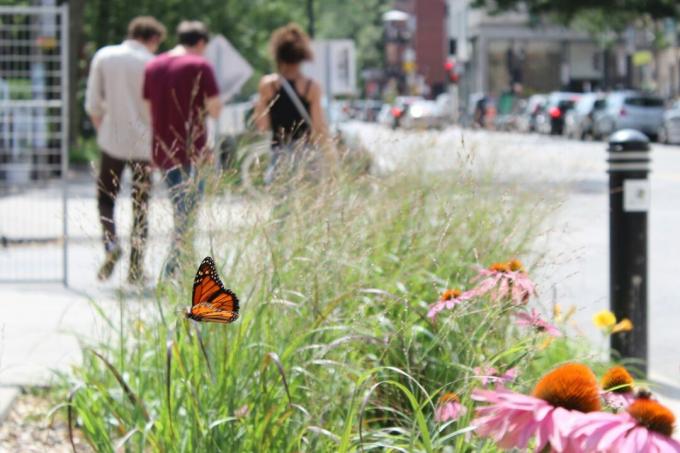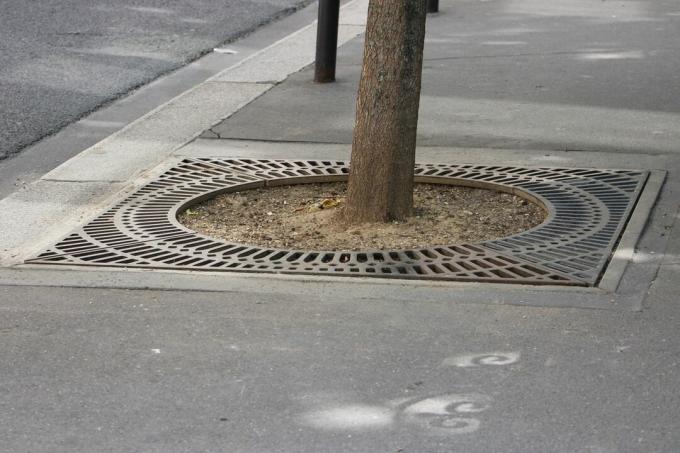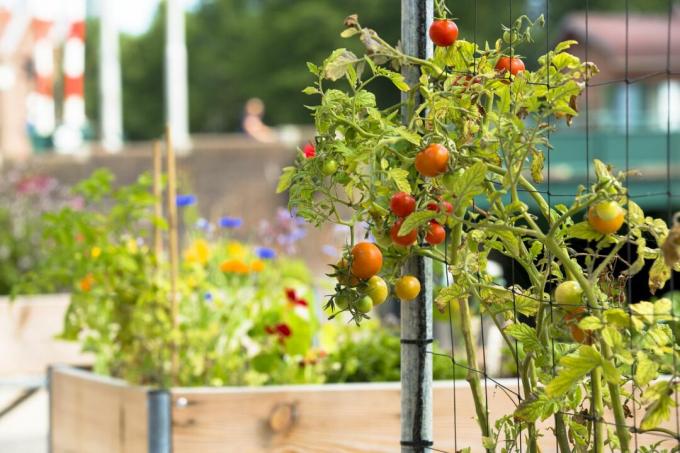In many cities there is a lack of green spaces and many people want a piece of green to cultivate. Street beds solve both: they beautify the cityscape, strengthen the neighborhood and offer insects a habitat.

Say goodbye to gray streets: street beds are a great way to make your city a little greener! In this article you will learn what exactly street beds are, what positive effects they have in the city and what you should consider when creating a street bed.
contents
- What do you mean by street beds?
- What are the advantages of street beds?
- Planting and creating street beds: The best tips
What do you mean by street beds?
We often encounter street beds every day, but we hardly notice them due to the typically simple planting. A street bed is understood to mean, for example, the shoulders on a street or traffic islands as well as generally any green area in the public street space of the community. The area around a street tree is called a tree bed. The so-called roadside greenery, which in most cases is grass, grows on these areas and therefore does not have a high ecological value and is also not really visually appealing is.
What are the problems with tree beds in the city? Unfortunately, these areas are often littered, used as a dog litter box, or used as bicycle parking. Cars parked on the road bed compact the soil and require road trees and other plants to be very robust and regenerative.

What are the advantages of street beds?
- Street Beautification: A flowering roadside bed offers more to the eye than bare soil or bark mulch. In addition, with a nicely planted tree bed, you think twice before throwing your rubbish there without thinking, as unfortunately often happens on a bare, weed-covered area.
- A contribution to biodiversity: Insects in particular are finding fewer and fewer habitats in our cities. This is one of the reasons for the decline in native insect species. Lawns, such as those found on roadsides or in the city in general, are of little ecological value and can be replaced with insect-friendly flowers. Of course, you should pay attention to environmentally friendly gardening and choose plants that are of value to our insects and not just look good. In this way, even people without a garden can contribute to the preservation of biodiversity.

- Improvement of the urban climate: Plants filter pollutants, the finest dust particles and of course carbon dioxide from the air and thus contribute to improved air quality in the city. In addition, plants have a major effect on the microclimate surrounding them, because they humidify the surrounding air through their transpiration. In addition, the water from rain and dew can hold better in the vegetation and thus ensure a cooler urban climate in summer.
- Improved Street Tree Vitality: The roots of the plants on the tree bed loosen up the often compacted soil around the tree, improving the soil quality. This allows more oxygen and water to reach the tree roots and enables the tree to grow better. In addition, dog owners are more likely to prevent their dogs from doing their business there if the bed is lovingly planted - this protects the tree from too much nutrient input. Dog urine contains very high concentrations of phosphorus, potassium and above all nitrogen in the form of urea. Too much of these nutrients makes plants vulnerable to pests and frost - so they take indirect damage from animal droppings.

- Strengthen community: A street bed can strengthen togetherness in your neighbourhood. From creating the bed to tending it, the bed offers opportunities to strengthen contact with other people. The tasks and care work can be shared in the neighborhood and seniors or people who have not been well integrated, for example people who have fled, can also get involved. Caring for the same thing creates a bond between gardeners. Interested parties passing by will definitely talk to you about the project and new acquaintances will be made. Perhaps others will also be inspired by your planted street beds and start creating and caring for one themselves.
Planting and creating street beds: The best tips
Of course, planting street beds is a nice project. However, there are a few things to consider before you head out with your shovel and seed:
Observe the legal regulations of the city: In principle, anyone who wants to plant a street bed should be aware that, strictly speaking, this is considered property damage. In order to avoid legal consequences, a certain amount of bureaucracy is required to implement the project in public green spaces. Contacts in this area are often the municipal green space maintenance, the green space management and often also nature conservation authorities. It is even possible to receive financial grants for eligible projects, but this also involves some effort. In general, one has to reckon with the fact that the submission of a concept, the naming of permanent contact persons and more will be required. Funding partners could be certain foundations or service clubs, for example, but crowdfunding is also a good way to get financial support for projects. If you are planning to create the flower beds in front of a local company, bank branch or similar, then it is worth asking them if they would be willing to sponsor the project. Depending on the design, it could also be good advertising for them. There are often rules for planting street beds, for example a maximum height of the planting so as not to obstruct the view of road traffic. In addition, the maintenance of the city trees by the employees of the green space office must be guaranteed at all times. Therefore, a certain planting distance to the tree is often specified.

- Prepare the street bed: Unfortunately, there is often a lot of rubbish in tree beds. The first step is to remove it. Be careful not to injure yourself on broken glass or similar. Unfortunately, the soil in the street bed is often not of good quality and is heavily compacted. The soil should therefore be loosened to a depth of at least 10 cm before planting and improved with a high-quality substrate. For example, our is suitable for this Plantura organic universal soil. The potting soil does not require peat and therefore has less CO2-Footprint than ordinary potting soil. Alternatively, mature compost can be used, which can be fetched from a recycling yard. However, do not pile up too much substrate around the tree trunk.

Plantura organic universal soil
Organic, peat-free & climate-friendly:
For all plants indoors & outdoors,
100% natural ingredients,
harmless to humans and animals
- Choosing the right plants: Depending on the light conditions, you should choose your planting. In general, it is important to select very robust plants that can withstand the extreme conditions right next to the road. It is particularly important that the plants in a tree bed can cope with a lot of root pressure, as the soil is already heavily rooted by the tree. At the Bund deutscher Staudengärtner you can get free concepts for planting tree discs. Sowing on such areas is also possible. Insect-friendly flower meadow mixtures like ours are particularly suitable for this Plantura bee pasture. The easy-care flower mixture consists of over 20 annual and perennial species. In general, when making your selection, be sure to choose insect-friendly plants to add value to your city.

Suitable plants for sunny tree beds include:
- Bee friendly ground cover: Carpet Phlox (Phlox subulata), blood red cranesbill (Geranium sanguineum), hot stonecrop (Sedum acre)
- Medium-sized perennials: Viper Bugloss (Echium vulgare), Size sedum (Sedum telephium), sun bride (Helenium), snake knotweed (Bistorta officinalis), coneflower (Echinacea purpurea), common chicory (Cichorium intybus), Rudbeckie (Rudbeckia), dyer's chamomile (Anthemis tinctoria), meadow sage (Salvia pratensis), bluebell (Campanula glomerata)
Further Insect friendly flowers can be found in our matching Plantura article.

Plantura bee pasture
Over 20 annual & perennial species for
Bees, bumblebees & co, easier to care for
Blossom dream in bed, pot & window box
- The right care: Especially in the beginning, the street bed should be watered regularly to ensure the growth of the plants or the sprouting of the seeds. Depending on the plant's requirements, you can water less after a few weeks. It is advisable to divide the watering among friends or in the neighbourhood. Weeds should also be removed at regular intervals and any rubbish removed. In some cities, fertilizing tree beds is not permitted to prevent uncontrolled nutrient input. Therefore, before fertilizing, ask the responsible green space office.
- Protect the street bed: To make the tree disc recognizable as a bed, a small fence is an advantage. However, this should also be discussed with the city, because this is not allowed everywhere. Alternatively, you can put up information signs or attach them to the tree, of course without damaging it. Especially at the beginning, when the seeds have not yet germinated, appropriate signs can encourage passers-by to be more considerate.

At a glance: The most important steps for creating a street bed
- Research city regulations
- Clear the bed of trash and weeds
- Loosen and improve soil
- Plan appropriate and environmentally friendly planting
- plant or sow
- Optional: protect the tree bed
Another idea for urban gardening is a Herb bed from pallets, which finds space on every balcony, no matter how small.
...and receive concentrated plant knowledge and inspiration directly in your e-mail inbox every Sunday!
